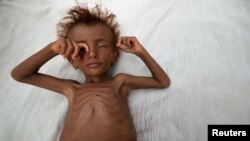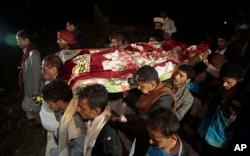The United Nations is appealing to the international community to pay more attention to Yemen, which it considers one of the worst humanitarian crises in the world.
Most media attention is on Syria, where the country's devastating, long-running civil war has killed more than 250,000 people and forced more than 11 million to flee their homes.
But U.N. officials fear this focus on the horrors playing out in Syria is overshadowing the desperate needs of more than 12 million people in war-torn Yemen.
Jens Laerke, spokesman for the U.N. Office for the Coordination of Humanitarian Affairs, said the war has destroyed the livelihoods of Yemen's people, robbed them of basic services and pushed the economy to near total collapse. He said children are one of its main victims.
“This year, the nutrition cluster estimates that there are 1.5 million [children younger than 5] who are acutely malnourished, of whom 375,000 are suffering from severe acute malnutrition,” Laerke said. “There are many, many others suffering from moderate malnutrition, indicative of the gravity and severity of the situation.”
The U.N. World Food Program (WFP), which distributes food to about 6 million people every other month, understands the gravity of the situation. But the WFP has cut back monthly food rations because it has run out of money and urgently needs $145 million to carry out its mission until the end of the year, says agency spokeswoman Bettina Luescher. She said everyone, but especially the children, are suffering from the food shortages.
“Even before the violence and the war in Yemen, the malnutrition rates of children in Yemen were the highest in the world,” she said. “So you have a little bit of a perfect storm coming together there.”
“Half of the children are stunted,” Luescher added, “meaning they are too short for their age because of chronic malnutrition.”
The difficulty getting food, fuel and other relief items into Yemen, Laerke said, is because of extensive damage to the port city of Hudaydah.
“Before the war, Yemen was over 90 percent dependent on import of basic food items and medicines,” he said. “Eighty percent of those imports come through Hudaydah port. That gives you an indication of the importance of that lifeline.”
“What is particularly urgent in the port is the rehabilitation and the repair of five cranes, which were damaged in an airstrike in August 2015, so they have been partly out of commission for quite some time,” Laerke added.
Laerke said it was very difficult and slow to get shipments of goods in the port offloaded for further transportation with the cranes in need of repair.
Saudi Arabia, an ally of the Yemeni government, began intensive airstrikes against the Houthi rebels at the end of March 2015. Airstrikes by the Saudi Arabian coalition have caused massive damage to the country's infrastructure.
Worse is the number of civilians who have been killed or wounded. New U.N. figures put the number of casualties from the start of the Saudi bombing campaign until the end of September at nearly 11,000, including more than 4,000 killed.
Rupert Colville, spokesman with the Office of the UN High Commissioner for Human Rights, said the casualties continue to mount. Since the latest estimates were issued, he said at least 10 civilians, including six children, were killed and 17 wounded in the Yemeni city of Taiz.
He said an artillery shell was fired Monday in a busy street near a market in an altercation between the warring parties.
“Witnesses who spoke to our staff in Yemen said the street where the market was located was crowded with people at the time of the attack,” he said. “There had not been any armed confrontations between warring parties in the Bir Basha area prior to this terrible incident.”
Stephen O'Brien, U.N. Under-Secretary-General for Humanitarian Affairs and Emergency Relief Coordinator, who has just concluded a three-day mission to Yemen, called for the urgent protection of civilians and for the safe and unhindered access for aid workers to deliver humanitarian assistance.
He said the U.N. has been scaling up its support and protection of the Yemeni people since 2015, but efforts to do more are being hampered by a lack of funds.
“So far this year,” he said, “aid workers have reached some 4 million people with assistance and protection. However, the Humanitarian Response Plan for 2016 is only 46 percent funded, leaving a gap of $880 million.”








